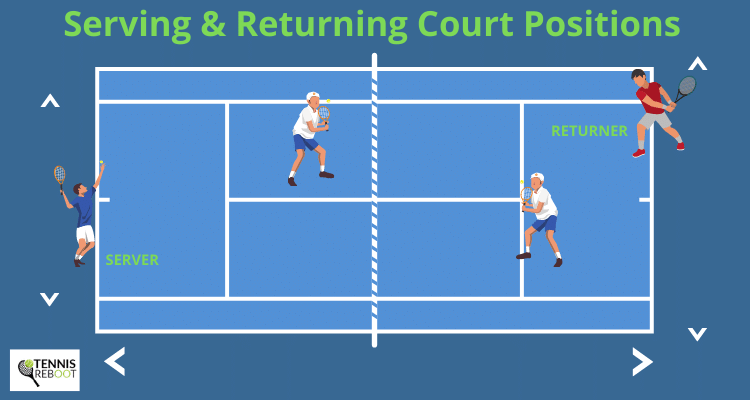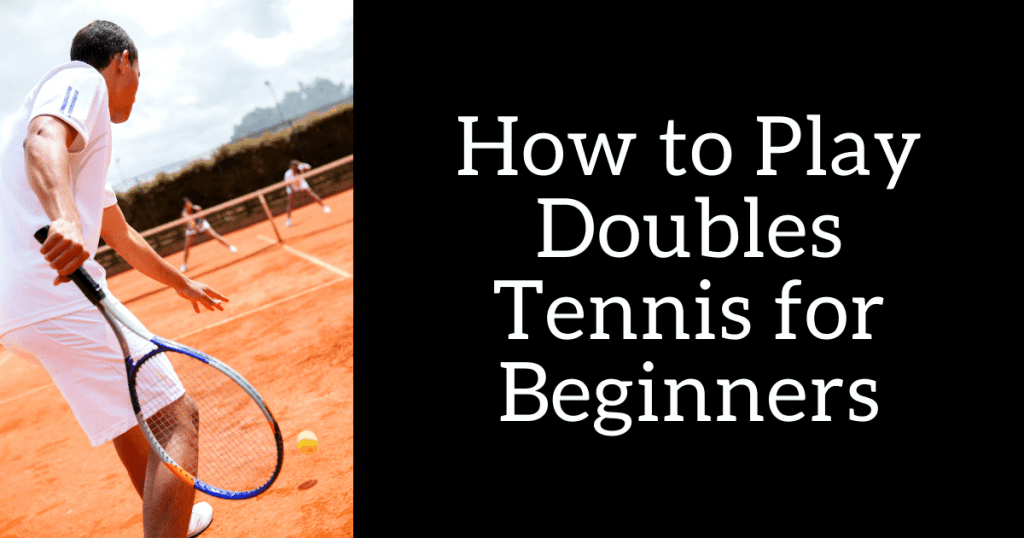When you’re just starting out in tennis, playing doubles is a great way to be out on the court, gain match experience, and have fun!
Playing doubles involves two teams of two players on each side of the court. It’s less strenuous on your body as you have less ground to cover and it is less pressure as there’s someone else out there who will also be wanting to hit the ball.
Winning a doubles match in tennis is all about staying active and alert. During the entire match, you and your partner will be playing together on the same side of the court.
Doubles tennis is all about teamwork.
Contents
Doubles Tennis Serving Rules

If you are the team that serves first, either you or your partner may serve the first ball to get the game going.
If the other team is serving first, one of them will serve to get the match going. Then, during the second game, either you or your partner will serve first.
If your team serves the first game, the opposing team will serve the second game, and you’ll switch off from there.
If you’re player A and your partner is player B with the opponents being players C and D, the order could go like this: A, C, B, D, A, and repeated.
Or it could go B, C, A, D, B and so on.
If the opposing team serves first it could go C, A, D, B, C, A, etc.
No matter who starts serving on either team, the order continues until the set is completed.
The Order of Doubles Returning
Throughout the entire set, the order of returning will continue back and forth both between teams and players.
When returning serve, you and your partner will have to determine which side of the court you want to be on.
If you want to be on the deuce (right) side, you’ll receive serve first in each game. If you want to be on the ad (left) side, you’ll receive second in each game.
You and your partner will alternate points receiving serve as that’s how doubles tennis is played.
In addition to alternating on returning serve, the two players also change court position.
When returning, you’ll be back near the baseline to receive serve. When not returning, you’ll be near the service line.
Note: In recreational tennis, the non-receiving player on the return team also helps with calling lines. Since you’re close to the service line and in a parallel position, you can more clearly see if a ball is on the line or behind the line.
Beginner Tennis Doubles Strategy
Considering all the ways you can learn about doubles will likely increase your skill level as a doubles player and you’ll probably enjoy yourself more.
Doubles is more than just two people on the same side of the net trying to whack the ball. There’s strategy. Touch shots. Communication. Teamwork.
Tennis Court Coverage
Since playing a doubles match involves you and your partner playing against another team of two, you and your teammate must cover the entire court.
This means accessing all of the space from the net to the baseline and both doubles sidelines.
Aside from hitting the serve into the serving box, every inch of the court is available for use during a point.
Doubles Tennis Serving Order

If serving is a strength of you and your partner, consider serving first.
At the professional level, often the team that serves first wins the match. Because the serve is often a weapon, holding serve occurs a lot in professional tennis.
Being the team that is always down a game can be mentally draining. Always having to serve to even the score can get in your head and then breaks of serve can occur.
In recreational tennis the serve isn’t quite as potent a tool to win or lose matches. Have fun out there.
A common way to determine service order is by someone spinning a racket. If you have a Wilson racket, the butt will have a W on it. Kind of like flipping a coin, someone will say, “M or W?”
Whichever way the racket lands, that’s who gets to pick whether or not to serve or return.
If you win the racket spin, change it up whether or not you opt to serve first!
Doubles Tennis Returning Tips
The best tennis returners have tremendous skill with their groundstrokes. They’re usually great hitters on both the forehand and backhand side.
In recreational tennis, returning is pivotal for getting the ball back in play. Many beginners try to hit the ball too hard and make mistakes either hitting the net or hitting far beyond the baseline.
Work at hitting consistent shots back over the net. The adage of “make them hit one more shot” is key. If your opponent makes an error, you win the point. If you make an error, your opponent wins the point.
Get comfortable returning on both your forehand and backhand sides, also considering if you’re going to hit cross court or try to catch the net person off guard by returning down the line.
Be ready for anything!
Doubles Tennis Communication
Doubles is all about teamwork. Talk to your partner. Give them encouragement. Consider positioning and whether you should be moving up to the net more or staying back.
Doubles can be so much fun when you and your partner are in sync, hitting well, and enjoying the time on the court – even if you aren’t winning.
Any day playing tennis is more fun than working!
Tips to Help You Win Your Next Tennis Doubles Match
- Stay light on your feet. If your feet seem like they’ve set in concrete, your ability to get that quick ball hit close to you may be compromised. Stay on your toes so you’re ready for anything that comes your way.
- If you and your partner are playing against other beginners, try to aim for your opponent. Doing so won’t give them much time to move away from the ball. Don’t whack at it to try to hurt anyone, but jamming someone with the ball tends to elicit errors.
- Always be aware of where the ball is on your opponent’s side of the net. If you hit a lob deep into the court, follow the ball and move closer to the net. If you hit a shot out toward the doubles alley on the deuce side, shift to your left a little bit so you can follow the ball.
- Change up your serve. If every first serve on the deuce side is out wide, your opponent will get used to the pattern and start to become very comfortable. Try to mix up your placement and pace so the returning is always wondering what you’re going to do.
Doubles Tennis FAQs
How is the ball served in doubles tennis?
Serving in tennis is always done diagonally.
The ball is served from the deuce court on one side to the deuce court on the other side of the net.
It’s served from the ad court on one side to the ad court on the other side of the net.

Is service placement important in doubles tennis?
As the serving team, try to keep the ball in the middle of the court. The reason for this is all about angles.
If the ball is in the middle of the court, the hitter doesn’t have as much room to hit aggressive angles against you.
The same strategy works during a point (not just a serve). Hitting down the middle can create chaos for your opponents.
If both players think the other player will get the ball, neither of them might hit it and then it’s your point.
If both players go for the same ball, they might smack rackets and the ball goes flying outside the court – your point.
Can you serve from the alley in doubles?
The tennis court baseline has a center hash mark directly in the middle.
When it’s your turn to serve, you can serve anywhere behind the baseline from the center mark all the way out to the edge of the doubles alley. This is based on personal preference.
In doubles, typically the server stands about halfway between the center mark and the singles line.
This is done for two reasons.
For one, it creates more angle opportunities for the server.
Secondly, if the return comes back very quickly and is angled out toward the doubles alley, the server is close by to hit a groundstroke.
If they were near the center mark, they’d have much more distance to travel to get to the ball.

Where should you stand if you aren’t the server?
If you aren’t serving, move closer to the net. The server will be back near the baseline.
The non-returning opponent will likely be close to the service line on their side. I’d recommend being closer to the middle of the service box if you’re the non-server.
This positioning gives you the ability to hit a volley with the ball higher clearance above the net than if you were further back into the court. You’ll also be able to poach if the situation feels right.
Many doubles points are won at the net. Get up there and hit some winning volleys!
What is the best way to return the ball?
The answer to this is about strategy and ability. It’s pretty standard to try to hit the ball low, but back in the direction toward the server (cross court).
This tends to be a higher percentage shot for a number of reasons:
- Physics – You’re using the directional nature of how the ball was served to you. Changing the direction of the ball is harder to do and it takes more force.
- Clearance – The net is lowest in the middle rather than out toward the posts,
- Open Court – If the net person doesn’t poach, the court is open for you to return the ball back to the server.
Can you change the serving order in doubles?
Yes, but only at certain times. Once a set has begin, the serving order is determined for the entirety of the set. At the beginning of a new set, either team can change the order of their serving and that order will continue for the entire set.
How many tennis balls are used during one doubles match?
In recreational play, typically three balls are used during one doubles match. Tennis etiquette suggests always having a fresh can of tennis balls on hand.
Doubles Anyone?
Hopefully you have a little more information in the tank to make your next doubles match a more pleasant experience. Doubles is a great social experience, can help you become more comfortable with court position and movement, allows you to work on your serve without having to carry an entire match – so many positives to playing doubles. Can’t wait to see you out there!
